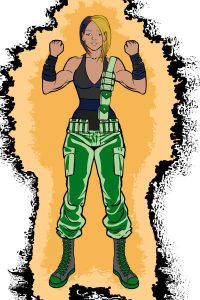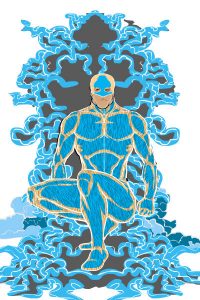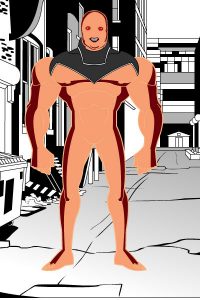Welcome back to Card Catalog where we hope not to see the same sort of service interruption again!? The non Seize the GM portion of life has been calming back down, so it is time to delve into more games and builds! This time around, we are looking back at Superheroics like we did with Mutants and Masterminds, but will be using a legacy system we hinted at in the Star Frontiers write up – the Marvel Super Heroes FASERIP system from TSR!
FASERIP is the acronym for the 7 primary attributes used in the system – Fighting, Agility, Strength, Endurance, Reason, Intuition, and Psyche. Before we get much further, it is important to note that TSR loved the underlying system concept so much, they were going to start using it for other games like Star Frontiers! It has an elegance in play that is hard to match, but sadly it didn’t survive to modern day as a formally supported game ….
But the fan community did not let it go! There is a robust level of support out there for the TSR Marvel Superheroes Game at websites like Classic Marvel Forever including ongoing ports of other supers. I may have to also dig out the Mayfair Games DC Set after listening to a bit of a back and forth between the two on the Hero Points Podcast! But enough of the side story – this is a system about playing superheroes designed in the 1980s specifically for Marvel Super Heroes and published by TSR – the golden ages of gaming and comics colliding here!
SYSTEM NOTES
The system is both elegantly simple, but with some deceptive complexity. Every test is resolved by rolling a pair of d10s as a percentile roll. This is compared against the success chart that comes from the strength of the attribute, talent, or power being used! There is even an easy color coded shorthand to explain how well you succeed. The levels of these attributes, talents, and powers are descriptive, with a specific numerical backbone. In the basic set, there was only one value in each of the descriptions, but the advanced set adds some more granularity mainly for the purposes of advancement. The ranks and their average values and starting values are are:
- Shift 0 (0/-)
- Feeble (2/2)
- Poor (4/4)
- Typical(6/6)
- Good (10/8)
- Excellent (20/16)
- Remarkable (30/26)
- Incredible (40/36)
- Amazing (50/46)
- Monstrous (75/63)
- Unearthly (100/88)
- Shift X (150)
- Shift Y (250)
- Shift Z (500)
This value determines the column for your rolls, which is why modifiers in this system are called Column Shifts. Each column shows an array of color coded results for your percentile roll creating a rather straightforward and understandable chance of success in the roll. The main attributes are:
- Fighting
- Agility
- Strength
- Endurance
- Reason
- Intuition
- Psyche
Then you have secondary attributes including Health, Karma, Popularity, and Resources. Health is pretty self explanatory, Karma serves as both experience to use for advancement and also for heroic agency like adding to your die rolls and not killing an opponent. Popularity & Resources both have tangible benefits in the game world! The Resources attribute was the first time I remember seeing wealth as a stat that you could grow and repeatedly use including rules for trying to use it too often too quickly, taking out loans to increase your current resources, and more. Popularity served to help determine how the public would react to you and it could matter! Do the police defer to you because of your heroic reputation, are you pretty much unknown, or do you have a reputation that could include active warrants for your arrest? It acted to simulate the comic book experience in a cohesive manner. The use of Resources and Popularity was a groundbreaking concept when I read it back in the day and it was certainly well ahead of its time.
Characters are mostly defined by their Powers but don’t overlook Talents and Contacts. Most of the character generation is done by random rolls but you can allow some selection to design a character rather than just roll one up. A house rule I’ve used is to allow one reroll or choice per category if something just doesn’t fit. That came up at least once in this generation set.
There are 5 different possible origins in the system, with different implications on which table you roll your Attributes on and how strong they can be – Altered Human, Mutant, High Tech, Robot, and Alien. Since I am going to make one of each, I’ll go into more details about each Origin in the subsequent characters. The list of powers is decently long in the Advanced Player’s Guide, but the Ultimate Power Book has a dizzying and near exhaustive array of powers that existing in comic books in the 1980s. For the purposes of this Card Catalog, I’ll keep with the core book for simplicity. One of the rather neat features of the system is how your character can develop a new power stunt. Using the power in a new and interesting way, or pushing the description to apply in a novel manner requires you to spend karma, 100 per attempt, for the first 10 attempts until it is considered learned. This rewards players to find new uses for their powers, maintains a dramatically appropriate chance at failure while learning, and prevents loophole arguments about the logical conclusion of a power’s description – don’t have tha listed, spend your karma and try to do it as a new stunt! While 1000 Karma may sound like a lot, it takes 10 x new rating to increase the power, so an Excellent (16) power takes 170 karma to get to Excellent (17) and it isn’t until you get to 26 that you crest into Remarkable, and that takes an extra 400 karma.
That forms the basics of the system and generation – random rolls for attributes on a percentile chart that varies per origin, roll for powers, talents, and contacts, and maybe have some degree of choice but for the most part this will be a loosely guided series of character creations.
You make a percentile roll with a pair of d10s and compare your result to the Universal Table under the column that shows the power level of your power, talent, or attribute you are using. Simple and straightforward. There are very few opposed rolls,for example in Slugfest (hand to hand) combat, you roll on the Table for your Fighting Attribute to see whether you hit. Instead of opposing, the other character may choose to make a roll of their own, such as choosing to block which has the blocker roll on the table for their Strength attribute to determine how much “body armor” will cut down on the damage. It is a fast and proactive system encouraging players to take actions.
There are specific subsystems and details for things like magic and building items or gear but those are deep dives that may require a follow up card catalog post. The magic system is wrapped around the existing power system, but it allows characters to pick up FEATs easier than if they were non-magical characters with a balance in the role playing and setting constraints characters would usually have for example.
Karma is earned and can be used for multiple purposes over the course of a story including character advancement but it also is used to manipulate the rolls! As far back as the 80s, you could spend your Karma before you rolled to increase the result. You also could reduce the rating of some attacks by spending karma because killing anyone resulted in a loss of karma that wasn’t already banked to advancement. A mechanical reflection of the state of the time the game was made!
Our little trip into the 90s of the comics era will use starting characters and mostly random rolls. A house rule I like is that you can reroll or choose one item in each category if it is just an odd ball out to make a more cohesive character.
Setting Overview
This is the same setting as you saw in the Mutants and Masterminds write up. A bit of indulgence perhaps for my own wholecloth superhero world, but that is what we do here at Seize the GM from time to time – make up stories.
Noone is quite sure how or why powers started popping up in human, much less when they started. What is clear is that the rate of powered humans, aliens, and magical beings showing up on Earth is increasing at an alarming rate. It had been a hundred years since the modern era had started with these extraordinary beings stepping onto the battlefield of World War I including the likes of Doughboy and Janissary. The 1960s saw the worldwide spread of these special people like Slugger and Der Kommissar which continued through the 1980s revival of battlesuits even as Slugger founded a third political party in the U.S. reshaping the global power structure. When a self proclaimed “Demon Lord” made itself known collecting a coterie of villains to challenge the status quo, the planet couldn’t sit back anymore.
With less likelihood of full scale conflicts, but a heightened frequency of small skirmishes between nation-states, the Global Commonwealth Agency, which replaced the League of Nations after World War I, was empowered to establish a peacekeeping force and to specifically deploy powered beings to counter threats found across the globe. It was the birth of the Argonauts.
Nightblade
It was in the shadow of this rebirth of heroes in the 1990s that Nightblade came together. In the era of extreme actions, lots of pouches, and an edgier kind of hero, this seems natural. Backed by a shadowy government organization, or so it appears, the Nightblade are the mix of public and secret in their work. The public activities of many of them help to insulate the secret work they do for their benefactors behind the scenes. As the GCA has formed the Argonauts with Espionage in a rather ostentatious manner, the Nightblade are being sent on far more proactive tasks. Backed by a government agency, or so it seems, Barracuda acts as a liaison for their direct action role, sometimes skirting the Argonauts or even coming into conflict with them. They are not the Heroes of yore, but are perhaps the heroes that the 1990s deserved.
The New Millennium Patriots have been a repeated thorn in their side so much so that perhaps there is more to this story than we know. Ever since the NMP chased Chimera into a warehouse where Barracuda, Brique, and Gun Bunny were training, they have been a constant presence.
Chimera
Mysterious Altered Human Metamorph
04/23/19

Chimera is in a lot of ways the person who put things in motion for Nightblade – her appearance spurred the creation of Nightblade as well as the longstanding enmity with the NMP. Chimera doesn’t know why the NMP are after her or what she is to them, but what she does remember is the faintest memories of the lab where she was subject to experimentation. She shows is clearly a metahuman from her physical capabilities, before she starts changing her shape. That shape changing is where her name comes from, sometimes stuck between two forms when she can’t quite control her powers. It is her running from the New Millenium Patriots that caused Nightblade to really gel, and Barracuda, Brique, and Gun Bunny were in the right place at the right time. Though her name, as Chimera is all she remembers, is may hold more truth than anyone realized at the time.
Akasha
Legacy Mutant Elemental Controller
04/30/19

Akasha’s codename means sky, or sometimes what you might call aether. His powers reflect his family’s long association with the powers to change the air and light, once seen as possibly something divine now seen as a curse – his parents believed in rebirth and in transcending that cycle but the more these powers show in the family line the less they saw that happening. Navin keeps his Identity Secret to protect his immediate family, but an innate desire to do good keeps him from being unsung and unseen. It was just that chance moment, when the New Millenium Patriots literally crashed through a building chasing Chimera that sprung him into action. Since then, he has tried to help temper some of his teammates who have become friends, especially as the NMP are now after him as well.
Barracuda
High Tech Connected Underwater Hero
05/07/19

Barracuda, or Peter Siden, spent time serving in the United States Military, and showed remarkable aptitude for mechanics and the ocean. The Navy transferred him to research labs to work on experiments, and eventually he entered into a dual status working with contractors and the government. He was sent to work with Dr. Chandler in a joint funded program, but that is a story that everyone now knows as the birth of the Atomic Avenger. What they may not know is that parts of the design were salvaged, especially around the core physical components of the suit, and Barracuda is one such derivation from that research. It may lack the raw power source and energy manipulation capacity of the Atomic Avenger suit, but it is well suited to underwater and reconnaissance work.
Brique
Magical City Earth Golem
05/14/19

Sometimes, life appears at the strangest moments. In the first battle between Demon Lord and what would become the Argonauts, magical energy was unleashed like the world had not seen. While Demon Lord was beaten back, the energy that mingled between its power and the hero’s power left a pinpoint crack to somewhere else. Brique came through, or at least the energy that formed into Brique came through. It took years to develop sentience, creating a body from the brick, concrete, and asphalt of the city, but slowly a mind formed. It is clear Brique is not from here, but for now Brique seems content to explore this tangible reality and do what needs to be done to protect it. It seems Brique knows something is coming, but won’t say what that is . . .
Gun Bunny
Pouch Wearing Alien Weapon Master
05/21/19

For all that the world has seen superhuman powers, battlesuits, and demons, aliens seemed to be the last thing on anyone’s mind. Sure, there were likely aliens that were hidden amongst the populace, and I do mean actual extraterrestrial from another planet or even another galaxy aliens, but there wasn’t a big deal about it. Until the 1990’s when it seems that first contact was the name of the game every week. L’prd’onia slipped through the cracks here as other species made their first contact scenarios. She landed and hid, found by the same shadowy organization that Barracuda works for and agreed to help out when Chimera crashed into their world. Covered in fur, with some relationship to the Leporidae family, or Rabbits, her facility with firearms left her the moniker “Gun Bunny”. She hasn’t cared to correct anyone since. Something about the NMP raised her hackles
Fillable Character sheets found at Classic Marvel Forever.
Character Designs done on Hero Machine 3.


